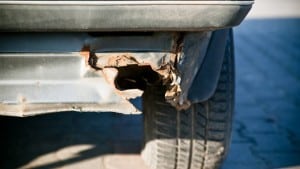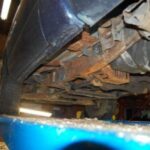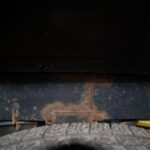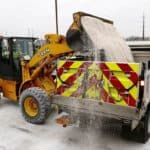Car Undercoating
Car and Truck Undercoating
Car Undercoating doesn’t come free, so it makes sense to do a little research and find out if getting Car undercoating is worth the cost. But wading into the sea of articles, posts, tweets and comments on the subject can be daunting. An article in Canada’s Moneysense website (Moneysense.ca) clears up the confusion. In her article “Is Rustproofing Worth the Cost?” Romana King writes:
If you lived in California, like Dan Edmunds, director of vehicle testing at Edmunds.com, he’d tell you after-market rust protection is a waste of time. But you don’t. You live in Canada, where ice, snow, salt and dramatic climate fluctuations, combined with thousands of kilometres of gravel roads, can chip away your car’s built-in protection in no time. Because of that, Edmunds believes that even drivers in temperate areas of Canada would benefit from car undercoating-rust protection.
As everyone who has spent a winter in New Hampshire know s, our climate is much more like Canada’s than California’s. We have the “ice, snow, salt and dramatic climate fluctuations.” And the only thing different about our gravel roads is that we measure them in miles instead of kilometers. King goes on to say that driving on gravel roads causes small stones to spray up onto your undercarriage. Over time this wears away at the surface and causes a lot of damage, creating an ideal environment for rust to take hold. According to King, if you plan to buy a new vehicle every year or two, then car undercoating-rustproofing isn’t worth it. But if you want to keep it for a while, you should definitely get it treated. King cites prices in Mississauga, Ontario, noting that car undercoating-rustproofing there costs about $150-$200 Canadian dollars for 12 to 18 months of protection and could save $1000 in repairs.
s, our climate is much more like Canada’s than California’s. We have the “ice, snow, salt and dramatic climate fluctuations.” And the only thing different about our gravel roads is that we measure them in miles instead of kilometers. King goes on to say that driving on gravel roads causes small stones to spray up onto your undercarriage. Over time this wears away at the surface and causes a lot of damage, creating an ideal environment for rust to take hold. According to King, if you plan to buy a new vehicle every year or two, then car undercoating-rustproofing isn’t worth it. But if you want to keep it for a while, you should definitely get it treated. King cites prices in Mississauga, Ontario, noting that car undercoating-rustproofing there costs about $150-$200 Canadian dollars for 12 to 18 months of protection and could save $1000 in repairs.
Undercoating a car or truck is one of the best ways to stop auto corrosion before it starts. Applying car undercoating to a vehicle puts a physical barrier between the exposed underbody and all the road debris just waiting to pummel it. That’s important, because road debris goes way beyond litter. It includes magnesium chloride and other chemical compounds used to de-ice asphalt and control dust. Once that stuff gets drawn up into your vehicle, it can stick like glue. By the time the corrosion becomes visible, its effects may already be widespread.
Here in New Hampshire, car undercoating-rustproofing starts at $159 at The Rust Stop Pros. So when you see all that conflicting information out there, some saying that car undercoating-rustproofing is worth it, some saying it’s not, take a look at the location. Once you sort out places like California from places like Canada and New Hampshire, the conflict disappears and the message clears up: New Hampshire vehicles should get car undercoating-rustproofing. Vehicles that are not exposed to ice, snow, salt and gravel probably don’t need it. King recommends an undercoating available in Canada called Krown. Here in New Hampshire, it’s known as NH Oil Undercoating®, which is available from NH Oil Undercoating®.
The fact is, a new vehicle is subjected to thousands of spot welds and numerous bends and folds during production.
This process damages the pre-coated metal, allowing exposure to the corrosion process. Besides cosmetic damage,corrosion also weakens a vehicle’s structural integrity and can affect steering and suspension components.NH Oil Undercoating® is designed to create a barrier that can’t be broken, chipped or cracked. By staying fluid, our petroleum-based rust protection heals back over after any abrasions providing lasting protection, even in extreme conditions!
The use of brine solutions is why you need to incorporate Car Undercoating Into your annual maintenance programs
The use of brine solutions to remove snow and ice from roadways has proven even more effective and more economical than rock salt, but for all motorists who do not include car undercoating into their regular maintenance planning will come at an increased cost. Brine is sprayed on as a liquid. It doesn’t bounce, lands where it’s directed and is 100 percent effective. Safer for you as a driver, and better for you as a taxpayer. That’s because brine — a liquefied compound with about 23 percent salt content — can be even more corrosive than its dry alternative to a car or truck’s exhaust system, gas tank and other undercarriage components, according to a new report from the American Automobile Association. Brine wants to eat through your car like a school of hungry piranhas, and more than 2 million gallons of the stuff has been sprayed on roads this winter in Northern Virginia, Maryland and the District.
Engineering experts with AAA have concluded these road-clearing materials have cost U.S. drivers an estimated $15.4 billion in rust repairs over the last five years, or approximately $3 billion annually.
The average fix for motorists costs $500, the report concluded.
Effects of salt on automobiles
In winter, salt crews work around the clock to prep roadways for safer driving. Although road salt is needed for safe winter driving, it also leads to many car troubles. A Utah study estimated that salt corrosion costs the US $16 to $19 billion per year. Car Undercoating could be the answer to substantially reduce those numbers.
Road salt reduces water’s freezing point and it turns ice into water chemically. Vehicle tires therefore no longer just slide on the ice, but can reach the pavement for traction. While road salt is critical to ensure safe driving in winter, it is very corrosive and could cause widespread damage to vehicles with out Car Undercoating over time.
Salt’s biggest threat to a vehicle is that is speeds up rusting with frequent exposure. Rust on specific car parts creates a host of problems, including sub frame damage and hydraulic brake system leaks. As vehicle’s construction leaves most of the underside wide open, salt damage most often takes place underneath the car and it can therefore be difficult to see.
Due to the open underside of most cars, the salt and water that is sprayed up beneath the vehicle simply sticks to the underside, where it sits and corrodes everything it comes into contact with.
Many drivers simply drive their vehicles into the garage after driving on salt treated roads. This means the snow, ice and salt from the road stays stuck to the underside of the car and rots away at its components.The corrosion could damage the car’s brake lines, coil springs, muffler and exhaust systems, and even the vehicle’s frame. Damage to the sub frame of a car happens often in areas with lots of snow.
As road salt is necessary, it becomes difficult to avoid these problems. One solution car owners can apply is to visit a car wash often during winter to help battle the detrimental effects of salt. Going through a car wash with an under-spray will reduce the possibility that salt and salt water will stay on the vehicle and cause corrosion.
Salt is so corrosive it can even eat away the paint on your vehicle after time, leading to rust problems on the frame and undercarriage. What is a high salt diet costing you?
One farm truck owner reports that she had two cases in the past 10 years where the brakes on her trucks failed due to the lines leaking or breaking. The salt was entrenched between the clamps that hold up the lines and, as the trucks weren’t washed often enough, the salt mixed with dirt and eventually rubbed right through the hose.Drivers are advised to avoid driving directly after salt is spread on roads, if possible, as this will minimize the amount of salt picked up by the car.
Although many drivers wash their cars at least once a month during the winter, others prefer to wait until spring. As salt is activated by heat, the corrosive effects speed up when the weather is warmer. Whenever you prefer to wash your vehicle, it’s a good idea to do so as soon as there is no more salt on the roads.
Are you washing your cars Undercarriage thinking it’s enough? Car undercoating isn’t necessary?
Washing Your Car May Not be Enough To be effective, New Hampshire rustproofing technology has to stay up to date with the chemicals being spread on our roadways. And that means the old solution of washing our undercarriages frequently may not be enough anymore. Magnesium Chloride May Eat More than Just Metal The reason for this is a chemical called magnesium chloride. It’s related to ordinary salt (sodium chloride) but reacts differently when it comes in contact with other substances. Magnesium chloride is added to many deicing mixtures because it increases the effectiveness of the mix, allowing maintenance crews to use less of it. Theoretically, this can lower the costs of keeping the roads safe, in terms of both money and the damage done to the environment. Unfortunately, the new deicing mixes don’t decrease the damage done to our cars.
The reason for this is a chemical called magnesium chloride. It’s related to ordinary salt (sodium chloride) but reacts differently when it comes in contact with other substances. Magnesium chloride is added to many deicing mixtures because it increases the effectiveness of the mix, allowing maintenance crews to use less of it. Theoretically, this can lower the costs of keeping the roads safe, in terms of both money and the damage done to the environment. Unfortunately, the new deicing mixes don’t decrease the damage done to our cars.
There’s evidence to suggest that magnesium chloride can destroy even rubber and plastic, including the insulation on your car’s electrical wiring. George Brodin, owner of Lead Foot Linda’s Ethics Automotive in Eagle-Vail, Colorado, has noticed an increase in electrical problems in his customers’ vehicles since the State of Colorado started spreading magnesium chloride on their roads. (Read the full article here.) And that’s in addition to the corrosive effect it has on metals. But that’s Colorado and we’re in New Hampshire. Do we still have to worry about magnesium chloride? Yes. On September 1, the State of New Hampshire extended its contract with its magnesium chloride supplier. To Keep Rust Away, Washing Your Vehicle’s Undercarriage May Not be Enough! Just washing it off may not be enough. Modern deicing mixes often include bonding agents to keep the rain from washing it off the roads. And while that can be good for people, helping to save lives by reducing the ice where we drive, it isn’t good for cars at all. The same bonding agents that keep the mixture clinging to the road after a rain shower also keep the mixture clinging to our cars after we leave the car wash. NH Oil Undercoating is Paving the Way in Rustproofing Technology So if car washes don’t work, what does? When applied correctly by qualified personnel, NH Oil Undercoating® protects your car from magnesium chloride and other deicing chemicals by forming a barrier between the car and anything that may be on the roads. The Rust Stop leads the way in New Hampshire oil undercoating technology. To learn more about why NH Oil Undercoating® is the answer to today’s New Hampshire rustproofing challenges, call 1-855-OIL-RUST or 603-491-9012 and keep your.
We have all seen those signs in front of car washes that say, “Salt eats cars!” The implication, of course, is that using the car washes’ services will remove the salt and prevent our vehicles from being eaten. In recent posts we have discussed why washing is not an effective rustproofing (or rust prevention) method. So where does that leave the car washes? Is washing your vehicle just a waste of money? No. Keeping your vehicle clean is a great idea, and it has many benefits. It’s just not a  reliable way to prevent rust. Although washing your undercarriage does help in rinsing salt and debris off of your vehicle it is not entirely effective. The de-icing materials today like magnesium chloride are cheaper and eco-friendly. Unfortunately they can form a mist that will cling to a vehicles undercarriage making it impossible to rinse them off. Washing your car is a little bit like washing your hands. We have heard for a long time that washing your hands before eating is a good way to prevent illness, but modern science tells us that it won’t do a thing to keep you from getting diabetes. That’s obviously no reason to stop washing your hands, and the fact that washing is not a fool proof car undercoating-rustproofing method is no reason to stop washing your vehicle.
reliable way to prevent rust. Although washing your undercarriage does help in rinsing salt and debris off of your vehicle it is not entirely effective. The de-icing materials today like magnesium chloride are cheaper and eco-friendly. Unfortunately they can form a mist that will cling to a vehicles undercarriage making it impossible to rinse them off. Washing your car is a little bit like washing your hands. We have heard for a long time that washing your hands before eating is a good way to prevent illness, but modern science tells us that it won’t do a thing to keep you from getting diabetes. That’s obviously no reason to stop washing your hands, and the fact that washing is not a fool proof car undercoating-rustproofing method is no reason to stop washing your vehicle.
We humans have a little hack we tend to use, to make it easier for us to think about things and communicate with each other. It’s called categorization. Our brains take all the information coming in about the world around us and put it in neat little mental boxes. Those boxes have nice, tidy labels on them, and we use these labels to communicate with each other. Two of these boxes might be labeled “rustproofed vehicle” and “non-rustproofed vehicle.” And if we’re not careful, we may make the mistake of thinking that a “rustproofed vehicle” is now magically incapable of rusting, no matter what.  Of course, the real world is not like that. Car Undercoating-Rustproofing with NH Oil Undercoating® (the best rustproofing out there, according to independent studies), dramatically reduces decay, prolongs the life of the vehicle and cuts repair bills by a significant margin. It is important to remember to make Rust another yearly maintenance item. Car Undercoating is available in New Hampshire from The Rust Stop Pro. Call (603)-491-9012 to schedule your appointment today.
Of course, the real world is not like that. Car Undercoating-Rustproofing with NH Oil Undercoating® (the best rustproofing out there, according to independent studies), dramatically reduces decay, prolongs the life of the vehicle and cuts repair bills by a significant margin. It is important to remember to make Rust another yearly maintenance item. Car Undercoating is available in New Hampshire from The Rust Stop Pro. Call (603)-491-9012 to schedule your appointment today.
The use of brine solutions to remove snow and ice from roadways has proven even more effective and more economical than rock salt, but for all motorists this has come at an increased cost.
That’s because brine — a liquefied compound with about 23 percent salt content — can be even more corrosive than its dry alternative to a car or truck’s exhaust system, gas tank and other undercarriage components, according to a new report from the American Automobile Association.
Engineering experts with AAA have concluded these road-clearing materials have cost U.S. drivers an estimated $15.4 billion in rust repairs over the last five years, or approximately $3 billion annually.
The average fix for motorists costs $500, the report concluded. Average cost of an annual application of car undercoating, $200
Call to ban road brine
The Motor Transportation Association of Connecticut has asked that state to ban the salt solutions, arguing their trucks have seen an increase in corrosion damage of all sorts — in brake shoes, brake valves, coil springs, frame rails, radiators and the like.
As in New Hampshire, Connecticut’s DOT increased its reliance on brine starting in 2006. Lawsuits have been filed by several common carriers against the state of Connecticut for prematurely destroying vehicles.Connecticut lawmakers discussed last fall a bill to require the state to come up with a “natural alternative” to brine. However a 2015 Connecticut Academy of Science and Engineering report contends no such alternatives exist that are as cost-effective and efficient as these liquid deicers.In its report, the group concluded there were fewer crashes in the years brine was used in Connecticut versus rock salt and sand.
Pack your vehicle and a warm garage ?
Corrosion can be made even worse by placing the vehicle in a warm garage, warm temperatures accelerate oxidation and this allows that sticky compound on the metal to remain in liquid form even longer.
The other dilemma is as a liquid, brine can more easy find its way into the crevices of a vehicle where surfaces are prone to hold moisture and generally unprotected. So, avoid warmer garages above 32°F. That temperature can support a relative humidity above 30 percent. If your car is coated with magnesium chloride, it will turn wet at that temperature: corrosion city. Chilly but not frigid in your garage at home or work? Same issue.
“Inside that garage is a 100 percent time of wetness and a very corrosive situation,”said Bob Baboian, an auto industry consultant and a fellow at the National Association of Corrosion Engineers. said Baboian, who has written two books on automotive corrosion. “Sometimes the corrosion rate can be 100 to 1,000 times faster in the higher humidity and the higher temperature.”
While the damage and the costs to repair them are indisputable, studies remain inconclusive on whether rust damage from New England winters is inevitable — whatever product is used to clear the roads.
NH Oil Undercoating® Rust Protection See the difference for yourself!

 Buy US Direct
Buy US Direct Buy CA Direct
Buy CA Direct Buy EU Direct
Buy EU Direct Buy DE Direct
Buy DE Direct
